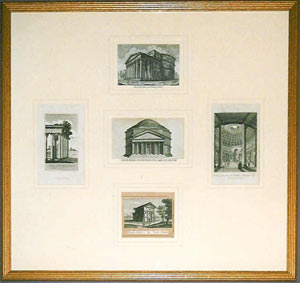|
LOOKING AFTER AND DISPLAYING YOUR PRINTS

Your print as sent by us is usually sent unmounted or unframed, for reasons of the size of package, economy and safety in transit. The print will be wrapped in conservation grade tissue, which will protect the surface. If you are not familiar with old prints, at this point you may be slightly disappointed, for the border areas of prints often seem to have attracted marks and wear not found on the print itself.
Mounts You should get the print into a mount or matt as soon as possible, apart from anything else as the appearance of a print is transformed by a smart mount!
A picture frame maker will usually be very happy just to prepare mounts. The mount should be of a generous size in comparison with the print, say 60 to 80mm bigger overall, and slightly deeper at the b ottom. This way, if you want to trim it back later for framing, you will not have to replace the mount. ottom. This way, if you want to trim it back later for framing, you will not have to replace the mount.
Mounts should always be made from acid free conservation board, for both the mount and the backing, with the print attached to the backboard.
This mount should as well be in a neutral pale ivory or parchment colour. If at a later date, for framing you want to introduce a coloured mount, this can be put over the existing mount, being made just 5 or 6 mm larger. This looks very attractive.
tissue paper of acid free conservation grade should at the very least be used to protect prints. This will stop the printed surface rubbing against other prints, but it is not really a long term solution, as each time the print is lifted or move, it will inevitably receive some more abrasion.
Storing and displaying your prints depends very much on why you are collecting them and how many you have got! Many collectors keep their prints in large flat boxes, sometimes called Solander boxes, which protects them from damage and the light. If you have collected dozens of prints, then at that point you will probably have too many for the walls anyway!
If you are concentrating on a special theme or themes, then it is much easier to study and compare prints if they can be spread out around you. Many prints of this nature may in themselves not be especially striking to display on the walls anyway.
temperature and humidity It is also important to keep prints in stable atmospheric conditions. It is generally recommended that the temperature should be in the range of 15 to 25° Centigrade and the humidity in the range of 50 to 60% RH. It seems to be accepted that the exact figure is not so important as the general stability – that is, these figures should not rise and fall too much.
Perhaps the greatest enemy of prints is too high humidity – that is, damp!! This leads to foxing – the appearance of lots of small brown spots – and seems to speed up the transfer of acids from old backboards, which gives a general brown colour. So, its better to keep prints in a warm dry room than a cold damp basement.

FRAMES AND DISPLAY Styles of framing for prints is of course a very personal matter and choice. We prefer fairly simple mounts and frames - a classic black and gold frame enhances almost any print. If it’s strongly coloured, then a frame that complements the colour will look good.
Grouping prints together is a very effective technique – a block of four or five quite modest prints can look very stylish. Another  nice technique is to group a number of very small prints together in one frame (sometimes called matting). Overall, we would say, “be generous”!! Nothing looks worse than a mean frame. nice technique is to group a number of very small prints together in one frame (sometimes called matting). Overall, we would say, “be generous”!! Nothing looks worse than a mean frame.
On the other hand, some types of prints suit ‘close framing’ – that is with the print right up against the edge of the frame. Portrait mezzotints from 1750 – 1800 were often originally framed in this way, and indeed are usually found trimmed close to the platemark.
However, there’s a problem. It’s not good for your print to touch the glass. The way round this is to put in a ‘slip’ mount – a very narrow mount no wider than 5 or 6 millimetres. If neatly done, it is invisible, but protects the print from touching the glass.
Whatever, we certainly recommend a full frame properly sealed to keep out dirty and insects. This is also much stronger. Clip frames or other temporary frames are not recommended.
exposure to light With framed prints on the wall, this question has to be considered. As with any antiques, its now widely recognised that exposure to light is probably their greatest enemy, for nothing can be done to reverse fading. In every country house and museum now, great efforts are made to keep light exposure to a minimum.
We are afraid that you really must adopt the same principle with your prints, especially if they are coloured. The black of a B&W print, being carbon, cannot fade, but the paper itself may ultimately degrade.
So, prints should be hung in the dullest rooms of your house. Normally in the northern hemisphere, these will be north facing. Avoid any location where direct sun will shine on the prints. Net curtains or blinds will help to reduce light. Tungsten, ie ordinary electrical light, seems to have very little effect, but with prints you should not use special picture lights, as with oil paintings. All this is good advice for any antiques!
email ross@georgianprints.co.uk
|